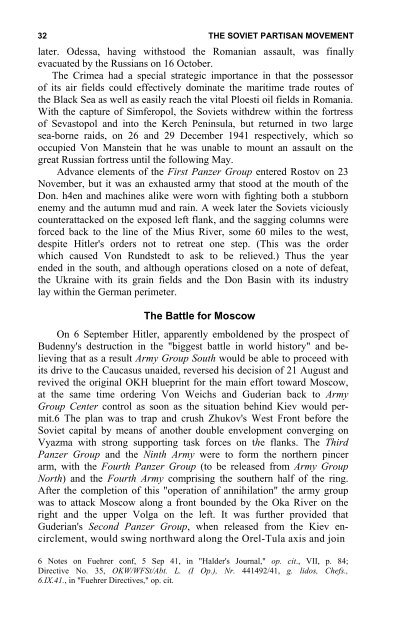the soviet partisan movement 1941-1944 by edgar m. howell
the soviet partisan movement 1941-1944 by edgar m. howell
the soviet partisan movement 1941-1944 by edgar m. howell
Create successful ePaper yourself
Turn your PDF publications into a flip-book with our unique Google optimized e-Paper software.
32 THE SOVIET PARTISAN MOVEMENT<br />
later. Odessa, having withstood <strong>the</strong> Romanian assault, was finally<br />
evacuated <strong>by</strong> <strong>the</strong> Russians on 16 October.<br />
The Crimea had a special strategic importance in that <strong>the</strong> possessor<br />
of its air fields could effectively dominate <strong>the</strong> maritime trade routes of<br />
<strong>the</strong> Black Sea as well as easily reach <strong>the</strong> vital Ploesti oil fields in Romania.<br />
With <strong>the</strong> capture of Simferopol, <strong>the</strong> Soviets withdrew within <strong>the</strong> fortress<br />
of Sevastopol and into <strong>the</strong> Kerch Peninsula, but returned in two large<br />
sea-borne raids, on 26 and 29 December <strong>1941</strong> respectively, which so<br />
occupied Von Manstein that he was unable to mount an assault on <strong>the</strong><br />
great Russian fortress until <strong>the</strong> following May.<br />
Advance elements of <strong>the</strong> First Panzer Group entered Rostov on 23<br />
November, but it was an exhausted army that stood at <strong>the</strong> mouth of <strong>the</strong><br />
Don. h4en and machines alike were worn with fighting both a stubborn<br />
enemy and <strong>the</strong> autumn mud and rain. A week later <strong>the</strong> Soviets viciously<br />
counterattacked on <strong>the</strong> exposed left flank, and <strong>the</strong> sagging columns were<br />
forced back to <strong>the</strong> line of <strong>the</strong> Mius River, some 60 miles to <strong>the</strong> west,<br />
despite Hitler's orders not to retreat one step. (This was <strong>the</strong> order<br />
which caused Von Rundstedt to ask to be relieved.) Thus <strong>the</strong> year<br />
ended in <strong>the</strong> south, and although operations closed on a note of defeat,<br />
<strong>the</strong> Ukraine with its grain fields and <strong>the</strong> Don Basin with its industry<br />
lay within <strong>the</strong> German perimeter.<br />
The Battle for Moscow<br />
On 6 September Hitler, apparently emboldened <strong>by</strong> <strong>the</strong> prospect of<br />
Budenny's destruction in <strong>the</strong> "biggest battle in world history" and believing<br />
that as a result Army Group South would be able to proceed with<br />
its drive to <strong>the</strong> Caucasus unaided, reversed his decision of 21 August and<br />
revived <strong>the</strong> original OKH blueprint for <strong>the</strong> main effort toward Moscow,<br />
at <strong>the</strong> same time ordering Von Weichs and Guderian back to Army<br />
Group Center control as soon as <strong>the</strong> situation behind Kiev would permit.6<br />
The plan was to trap and crush Zhukov's West Front before <strong>the</strong><br />
Soviet capital <strong>by</strong> means of ano<strong>the</strong>r double envelopment converging on<br />
Vyazma with strong supporting task forces on <strong>the</strong> flanks. The Third<br />
Panzer Group and <strong>the</strong> Ninth Army were to form <strong>the</strong> nor<strong>the</strong>rn pincer<br />
arm, with <strong>the</strong> Fourth Panzer Group (to be released from Army Group<br />
North) and <strong>the</strong> Fourth Army comprising <strong>the</strong> sou<strong>the</strong>rn half of <strong>the</strong> ring.<br />
After <strong>the</strong> completion of this "operation of annihilation" <strong>the</strong> army group<br />
was to attack Moscow along a front bounded <strong>by</strong> <strong>the</strong> Oka River on <strong>the</strong><br />
right and <strong>the</strong> upper Volga on <strong>the</strong> left. It was fur<strong>the</strong>r provided that<br />
Guderian's Second Panzer Group, when released from <strong>the</strong> Kiev encirclement,<br />
would swing northward along <strong>the</strong> Orel-Tula axis and join<br />
6 Notes on Fuehrer conf, 5 Sep 41, in "Halder's Journal," op. cit., VII, p. 84;<br />
Directive No. 35, OKW/WFSt/Abt. L. (I Op.), Nr. 441492/41, g. lidos, Chefs.,<br />
6.IX.41., in "Fuehrer Directives," op. cit.
















